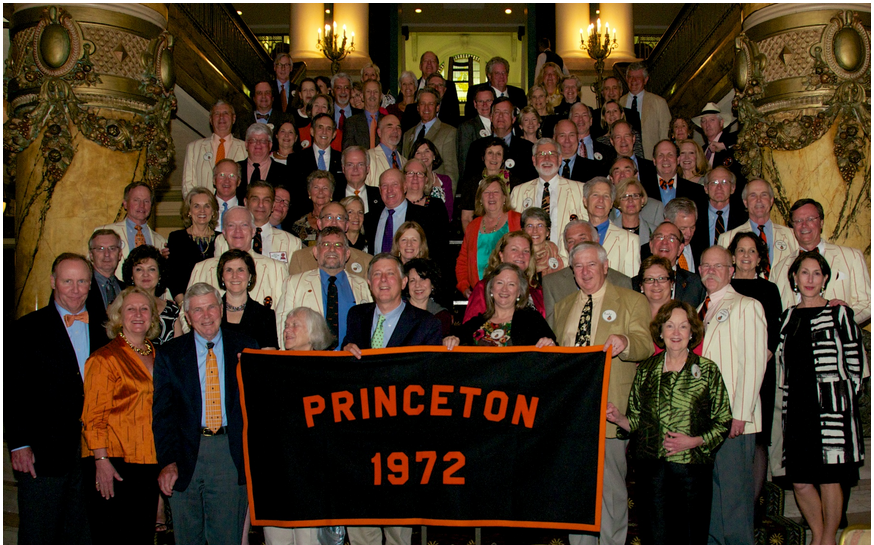 |
 Class of 1972 Virginia Civil War Battlefield Tour, April 10-14, 2013 by Ed Strauss, Class Historian
Participants in the sixth Class of 1972 Civil War Battlefield Journey mustered in Virginia’s (and the Confederacy’s) capital city, Richmond, on Wednesday April 10, 2013. Some were on their first tour in the uniquely enlightening company of Princeton’s professor of history emeritus Jim McPherson and his wife Pat (both honorary members of 1972); others had been on all five previous trips, dating back to 2004 (to Gettysburg, twice; Antietam-Harpers Ferry, Shiloh-Vicksburg, and Chattanooga-Atlanta). Classmates and spouses traveled from as far as Vermont, Texas, Colorado, California, and Oregon. In contrast to the record-breaking 91-degree temperatures in the city that afternoon, some travelers were delayed by Midwestern snowstorms. We checked in at the majestic Jefferson Hotel in downtown Richmond and gathered for cocktails in its soaring Rotunda, then moved on to the Empire Room for a buffet dinner inaugurating the program.
Thursday morning we boarded two comfortable chartered buses and drove about sixty miles due north on I-95 to the venerable town of Fredericksburg on the Rappahannock River. Our first stop was the riverbank site where Ambrose Burnside's Union forces crossed by pontoons into the town, under Confederate gunfire, December 11-12, 1862. On December 13, once a sizeable number of Union regiments had funneled across the river into Fredericksburg, their commanders repeatedly launched futile, bloody assaults against Confederate defenders entrenched on Marye’s Heights just beyond the far side of town. We walked along the notorious sunken road and its stone wall behind which riflemen poured murderous fire upon successive waves of attacking Northerners, not one of whom reached the wall. We then drove south to the farthest right end of the Confederate defenders’ line, at Prospect Hill, scene of another Union river crossing and bold advance which briefly broke through but was bloodily repulsed. We then headed west along the Plank Road, paralleling the Rappahannock, to the May 1863 battlefield of Chancellorsville, scene of another massive Union advance toward Richmond not quite six months after the Fredericksburg fiasco. As before, the Confederates were led by Robert E. Lee, ably seconded by Thomas "Stonewall” Jackson, who led a daring, undetected, day-long forced march through the woods, swinging far around the troops encamped on the unsuspecting Union flank, then launched a surprise late-afternoon attack that sent O.O. Howard’s whole shattered XI Corps reeling -- in a day which ended with Jackson’s being mortally wounded by friendly fire. We traced a bit of Jackson’s densely wooded route past Catharine’s Furnace to the scene of the XI Corps’ debacle and Jackson’s fatal wounding. We then viewed the scene of the following day’s artillery duel between Confederate cannon at Hazel Grove and Union guns at Fairview, sited near General "Fighting Joe” Hooker’s headquarters at the now-ruined Chancellorsville Inn (where Hooker was temporarily stunned by a cannonball striking a front-porch pillar on which he was leaning). Thursday evening, after returning to Richmond, small groups of us enjoyed a "dine-around” in more than a dozen different local restaurants recommended by local ’72 power couple Jack and Meg Crews (on our day-trips we enjoyed delicious box lunches from Sally Bell’s, just one more invaluable connection by Jack and Meg). Friday morning we took the same bus route from Richmond to battleground just to the west of Chancellorsville where we’d been on Thursday. Here in early May 1864, almost exactly a year later than the events we’d covered the day before, the massive U.S. Army of the Potomac, now commanded by George Meade but under the overall leadership of Ulysses Grant, again forded the Rappahannock and immediately sought battle with Lee’s Army of Northern Virginia in the entangled forest called The Wilderness, where fighting raged for several days. We viewed the scenes of some of the most ferocious combat -- Saunders Field, the Widow Tapp’s Farm, the fiercely contested intersection of Brock and Plank Roads. Unlike their predecessors -- Burnside at Fredericksburg in 1862 and Hooker at nearby Chancellorsville in 1863 -- this time Meade and Grant came expressly to fight Lee head-on, and did not slink away after several days of ferocious brawling, but instead pressed further south to the key road junction of Spotsylvania Courthouse, around which the fighting raged for several weeks, notably at the "Mule Shoe” and "Bloody Angle” entrenchments, the remnants of which we tramped along and surveyed close-hand, while benefiting from the expertise, analysis, and superb commentary of Prof. McPherson. Back to Richmond and an elegant dinner in the Marble Hall of the Virginia Museum of Fine Arts, another of the city’s dramatic interior spaces, after an opportunity to view some of the museum’s renowned holdings. On Saturday we visited battlefields closer to the capital city itself, starting with the sites of the Seven Days’ Battles, June 25-July 1, 1862, where Lee repeatedly pummeled the invading Union forces of Gen. George McClellan, pushing them back from the outskirts of Richmond (Battles of Mechanicsville / Beaver Dam Creek, Gaines’ Mill -- Lee’s largest attack of the whole Civil War -- Glendale / Frayser’s Farm, Malvern Hill) in a mix of aggressive combat, steady intimidation, and stealth -- playing upon McClellan’s ungrounded fears of a lopsidedly overwhelming foe -- all the way to the banks of the James River and eventual evacuation. We also had a look at the Cold Harbor battlefield, where, May 31-June 12, 1864, the forces of Grant -- as close as he would get to Richmond before its eventual surrender, eleven months later -- and Lee, having fought to a draw at Spotsylvania and maneuvered south, dug in and pounded each other from face-to-face entrenchments -- a brutal harbinger of warfare to come on the Western Front in France, fifty years later. We ended the afternoon retracing the path of Confederate troops’ futile advance up the gentle slope of Malvern Hill in the face of withering Union artillery fire, on the seventh day of the Seven Days’ Battles, July 1, 1862 (one year before the first day of Gettysburg). Saturday evening, having completed our tour of eighteen months’ worth of battlefield sites around the capital, we enjoyed cocktails and a gala dinner at Richmond’s Commonwealth Club, under the gaze of numerous portraits of Confederate generals, and words of welcome from Ed Ayers, President of the University of Richmond. We presented Prof. McPherson, already an honorary member of the Class, with our 25th Reunion jacket in recognition of all he has given us in the past ten years. On Sunday -- 84-strong, including 49 Classmates, 30 spouses, 3 friends, 1 widow, and 1 father-in-law -- we said farewell and headed off to various compass-points, including a contingent who headed west to Appomattox.
Tour stops, locations of note:
Thursday, April 11: Fredericksburg: Rappahannock pontoon crossing, Battlefield Visitor Center, Sunken Road, Stone Wall, Marye’s Heights, Cobb Monument, Innis House, Kirkland Monument, National Cemetery; Prospect Hill, site of Federal breakthrough.Chancellorsville: Battlefield Visitor Center and site of Jackson’s wounding, Lee-Jackson Bivouac, Catharine Furnace remains, Jackson’s flank attack site, batteries at Hazel Grove and Fairview, Chancellorsville Inn site. Friday, April 12: The Wilderness: Saunders Field Exhibit Shelter, Gordon’s flank-attack trail, Widow Tapp Farm, Texas Brigade Monument, Vermont Monument, Brock Road-Plank Road intersection. Spotsylvania: Exhibit Shelter, site of Sedgwick’s death, Laurel Hill, site of Upton’s attack, Mule Shoe, Bloody Angle, site of McCoull House. Saturday April 13: Chickahominy Bluff, Mechanicsville / Beaver Dam Creek / site of Ellerson’s Mill, Gaines’ Mill (Watt House), Cold Harbor Visitor Center, opposing Union and Confederate entrenchments at Cold Harbor, Hancock County Park, Savage’s Station, White Oak Swamp, Glendale / Frayser’s Farm, Malvern Hill (Parsonage ruins, route of Confederate attack on the West House). |
 |

